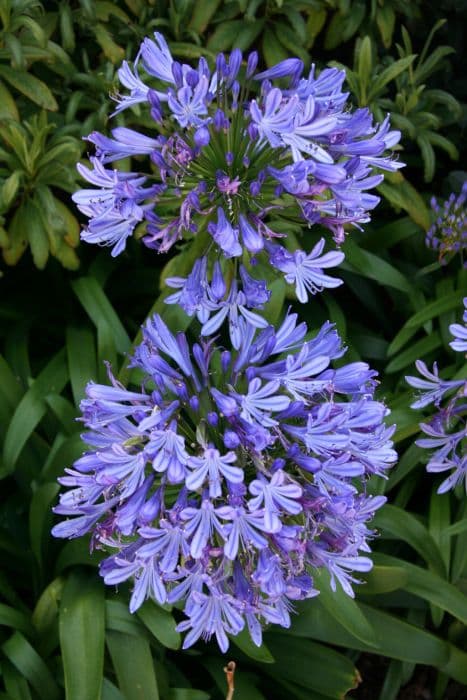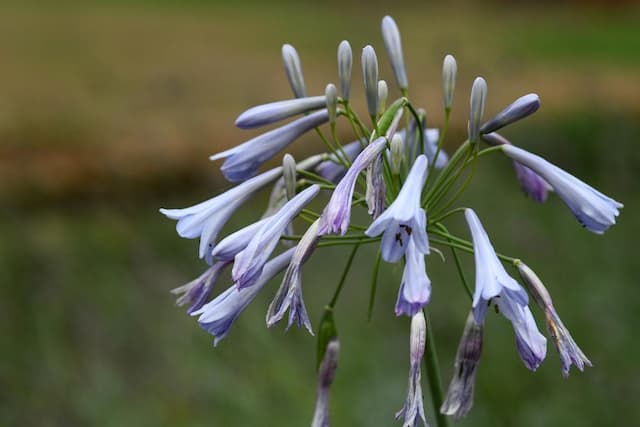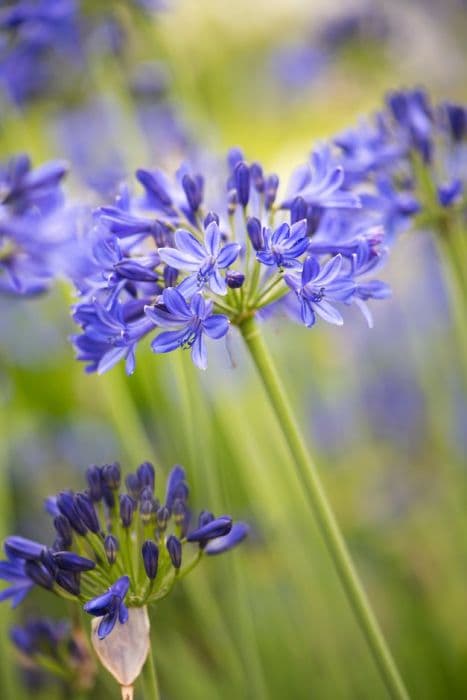African Lily Agapanthus 'Albatross'

ABOUT
The Agapanthus 'Albatross' is a striking plant, primarily recognized for its captivating floral display. Atop sturdy stems, it boasts large spherical clusters of trumpet-shaped flowers, which exhibit a pristine white color. These bloom clusters create a dramatic visual effect that appears like an explosion of star-shaped white blossoms. The lush green foliage forms a dense base of long, slender leaves that gracefully arch outward, providing a verdant backdrop to the flowers. The plant exudes an elegant and robust character, with the flowers rising above the foliage like radiant globes of white light. The Agapanthus 'Albatross' is a true garden gem, with a bloom period that adds a touch of sophistication to any landscape.
About this plant
 Names
NamesFamily
Amaryllidaceae
Synonyms
Lily of the Nile, African Lily, Love Flower
Common names
Agapanthus 'Albatross'.
 Toxicity
ToxicityTo humans
Agapanthus, commonly known as Lily of the Nile or African Lily, can be toxic to humans. If ingested, the plant can cause gastrointestinal symptoms such as nausea, vomiting, and diarrhea. It may also cause skin irritation when handled, especially if you come into contact with the plant's sap. Ingesting large quantities of Agapanthus can lead to more severe symptoms, including difficulty swallowing, excessive salivation, and on rare occasions, inflammation or swelling of the throat. It is advisable to keep this plant out of reach of children who might accidentally ingest it.
To pets
Lily of the Nile or African Lily is also toxic to pets. If animals ingest Agapanthus, they might experience symptoms similar to those seen in humans, including nausea, vomiting, and diarrhea. In dogs and cats, consumption of this plant can also lead to lethargy, abdominal pain, and drooling. It is important to prevent pets from consuming any part of the plant and to seek veterinary attention immediately if you suspect your pet has ingested Agapanthus.
 Characteristics
CharacteristicsLife cycle
Perennials
Foliage type
Evergreen
Color of leaves
Green
Flower color
White
Height
3 feet (0.91 meters)
Spread
2 feet (0.61 meters)
Plant type
Bulb
Hardiness zones
8
Native area
South Africa
Benefits
 General Benefits
General Benefits- Ornamental Value: Agapanthus 'Albatross', commonly known as African Lily, boasts large, showy umbels of trumpet-shaped flowers which add aesthetic value to gardens and landscapes.
- Drought Tolerance: Once established, African Lilies are quite drought tolerant, making them suitable for gardens in arid climates or areas with water usage restrictions.
- Low Maintenance: They require minimal care once established, needing only occasional watering and fertilization, making them a convenient choice for busy gardeners.
- Attracts Pollinators: The blossoms of the African Lily attract bees, butterflies, and other beneficial pollinators, supporting local ecosystems.
- Long Blooming Period: African Lilies have a long flowering season, often from late spring to late summer, providing consistent color in the garden.
- Versatility in Landscaping: They can be used in a variety of garden settings, such as borders, container gardens, and as focal points due to their striking appearance.
- Perennial Growth: As a perennial plant, African Lilies come back year after year, making them a cost-effective and long-lived addition to the garden.
- Deer Resistance: African Lilies are generally resistant to deer, making them a good choice for gardens in areas where deer browsing can be a problem.
- Tolerance to Coastal Conditions: They are well-suited to coastal gardens as they tolerate salt spray and winds, making them ideal for seaside planting schemes.
 Medical Properties
Medical PropertiesThis plant is not used for medical purposes.
 Air-purifying Qualities
Air-purifying QualitiesThis plant is not specifically known for air purifying qualities.
 Other Uses
Other Uses- Photographic Subject: Agapanthus 'Albatross', commonly known as Lily of the Nile, is often used by photographers for its striking blooms that can add dramatic effect to garden and nature photography.
- Fabric Dye: The flowers and leaves may be used to create natural dyes for fabrics, giving a subtle color that is often used in artisan crafts.
- Ink Making: Similarly, the plant's natural pigments can be used to produce ink for art or writing purposes, capturing the shades of blue and purple found in the flowers.
- Educational Tool: Due to its interesting flower structure, the Lily of the Nile can be used in schools or educational programs to teach students about plant biology and pollination.
- Garden Borders: The plant's clumping nature and lush foliage make it an excellent choice for creating defined borders in gardens and landscape designs.
- Feng Shui: In the practice of Feng Shui, the Lily of the Nile can be used to add an element of water to a space, symbolizing calmness and serenity.
- Artistic Muse: Artists may use the flower as a muse for paintings, sculptures, and other artworks because of its unique form and beauty.
- Culinary Garnish: While not widely known for culinary uses, the blossoms can be used as an ornamental garnish for special dishes, although they are not edible.
- Flower Arranging: The long-lasting blooms and stiff stems of Lily of the Nile make it a popular choice for inclusion in floral arrangements and bouquets.
- Craft Projects: The sturdy leaves and stems can be used in various craft projects, from weaving to creating natural wreaths and other decorative items.
Interesting Facts
 Feng Shui
Feng ShuiThe African Lily is not used in Feng Shui practice.
 Zodiac Sign Compitability
Zodiac Sign CompitabilityThe African Lily is not used in astrology practice.
 Plant Symbolism
Plant Symbolism- Love Letters: Agapanthus is derived from the Greek words 'agape' meaning love, and 'anthos' meaning flower. It is often considered as a symbol of love or sometimes used to represent a love letter.
- Strength and Resilience: The Agapanthus plant, also known as the African Lily, can thrive in various conditions, symbolizing strength, resilience, and adaptability.
- Beauty: With its striking appearance, the African Lily represents beauty and elegance, often used in gardens and bouquets to add aesthetic value.
- Fertility: Due to its lush and prolific blooming nature, it symbolizes fertility and abundance which may relate to both personal growth and procreation.
- Secret Love: Sometimes, Agapanthus can depict a secret love or admiration, making it a subtle gift for someone the giver has deep feelings for.
 Water
WaterLily of the Nile requires consistent moisture during the growing season, but be cautious not to overwater. The plant should be watered deeply once a week, providing about 1 inch of water which equates to about 0.623 gallons per square foot. During hot, dry periods, watering frequency may increase to twice a week. In the winter, when the plant is dormant, reduce watering to every few weeks, just enough to prevent the soil from drying out completely.
 Light
LightLily of the Nile thrives best in full sun to partial shade. The ideal spot is where the plant receives at least six hours of direct sunlight per day but is sheltered from the intense midday heat. Dappled or afternoon shade is beneficial in particularly hot climates to protect the blooms and foliage.
 Temperature
TemperatureLily of the Nile prefers temperatures ranging from 50 to 80 degrees Fahrenheit but can survive temporarily in temperatures as low as 28 degrees Fahrenheit. The optimal temperature range for active growth is between 60 and 70 degrees Fahrenheit. It's important to protect the plant from frost, which can cause damage to foliage and reduce flowering.
 Pruning
PruningPrune Lily of the Nile to remove spent flower stalks and encourage additional blooms. Deadheading the flowers as they fade can enhance the plant's appearance and promote a second bloom. The best time for pruning is in late winter or early spring when new growth begins, at which time any damaged or dead foliage from the winter should also be removed.
 Cleaning
CleaningAs needed
 Soil
SoilThe best soil for Lily of the Nile, or Agapanthus 'Albatross', is well-draining, fertile, and loamy with a pH of 6.0 to 8.0. A mix comprising two parts loam, one part perlite or sand, and one part peat moss or compost is ideal to ensure proper drainage and fertility.
 Repotting
RepottingLily of the Nile should be repotted every 3 to 4 years or when it becomes root-bound. During repotting, it's important to split large clumps to promote vigorous growth and blooming.
 Humidity & Misting
Humidity & MistingLily of the Nile prefers moderate humidity levels but is quite adaptable and can thrive in the typical humidity range found in most homes and gardens.
 Suitable locations
Suitable locationsIndoor
Provide bright indirect light, water regularly.
Outdoor
Full sun to partial shade, well-draining soil.
Hardiness zone
8-11 USDA
 Life cycle
Life cycleThe Agapanthus 'Albatross', commonly known as Lily of the Nile, begins its life cycle when a seed germinates, usually in spring, developing a primary root and shoot. As it grows, the plant forms a clump of strap-shaped, semi-evergreen leaves from which new growth will emerge in subsequent seasons. During its vegetative stage, the foliage expands and the underground rhizome system strengthens, storing energy for flowering. Between late spring and summer, mature plants produce tall, sturdy stems topped with globular clusters of trumpet-shaped white flowers, attracting pollinators to the garden. After flowering, seeds develop within the spent flower heads and can self-sow if not deadheaded, propagating new plants. In autumn, the plant begins to go dormant, with foliage dying back in colder climates, while in milder zones the leaves may persist, completing its annual life cycle.
 Propogation
PropogationPropogation time
Spring-Early Summer
Agapanthus 'Albatross', commonly known as African Lily, is best propagated by division, which is also the most popular method for this plant. The ideal time to propagate by division is in the spring or early summer when the plant has finished blooming and is beginning to enter a period of active growth. To propagate by division, carefully lift the clump of the plant from the soil, using a spade or garden fork. Gently separate the clumps into smaller sections, ensuring each section has at least one or two growing points or shoots. These individual sections can then be replanted immediately into well-prepared soil, spaced about 12 to 18 inches (30 to 45 centimeters) apart to allow adequate room for growth. It is important to water the newly planted divisions thoroughly to help establish them. This method of propagation allows the African Lily to increase in number while also rejuvenating older clumps that may have become too dense.









![African lily [Double Diamond]](/_next/image?url=https%3A%2F%2Fplants-admin.emdemapps.com%2Fimages%2Fplants%2F%2Fimages%2F604b558c4357a.png&w=640&q=75)